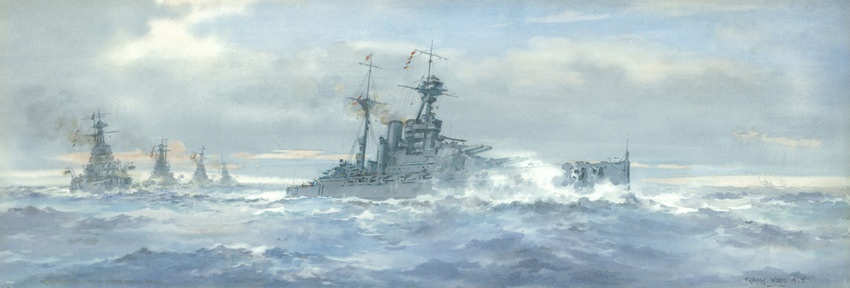QUEEN ELIZABETH CLASS BATTLESHIPS AT SEA
(MP162). Frank Watson Wood (1862-1953). Watercolour signed and dated (LR) 1925..

Limited Edition worldwide: 25 copies
Standard size: 25 x 9 ins (63.5 x 22.8 cms ) approx.
Price band (mounted/matted): £150-175
This fine watercolour has been annotated, verso, in pencil, “Spring 1924” although the painting was not actually completed, signed and dated until sometime the following year, 1925, by which time four of the five ships shown here were part of the Mediterranean Fleet.
As this website has written on frequent occasions throughout its pages, the five battleships of the Queen Elizabeth Class were in a league of their own when it came to all round excellence. For several years they were the largest, most powerful and fastest warships in the world; they were oil fired (a first for capital ships); they carried the heaviest armament then afloat (the 15 inch (380mm) gun with a shell that weighed just under 2000 lbs (over 870 kilos), and they could steam at the then impressive speed for a battleship of around 24 knots. And they really “looked the business” - they were beautifully symmetrical in appearance, bristled with huge turrets forrard and aft, had two pleasingly tall, matched funnels and had an aggressive yet beautiful look to them. No wonder artists such as WL Wyllie and Wood couldn’t resist painting them on every possible occasion! All did valuable service in World War 1 (indeed four of the squadron of Queen Elizabeths, the “Famous 5th”, arguably saved Beatty’s bacon at Jutland by being there, with his vulnerable battle cruisers, to dish out heavy, long reach blows whilst, critically, being able to absorb accurate and heavy German shellfire in return. They were the mainstay of the Royal Navy’s fast battleship force between the wars and in World War 2, when all had been modernised to varying degrees, they were once again in big demand. Except for BARHAM who fell victim to a U Boat in the Mediterranean, they all survived, WARPITE becoming the most celebrated ship of a class that had all consistently turned in above average performances in both world wars. They truly were a successful class and Frank Wood does them due justice as he shows them here slicing their way through a heavy swell.
In spring 1924 HMS QUEEN ELIZABETH (Captain Charles Forbes DSO RN) was flagship of the Commander-in-Chief Atlantic Fleet, Admiral Sir John de Robeck Bt GCB GCMG. Chief of Staff was Rear Admiral WW Fisher CB MVO and the Flag Commander, Commander the Hon Edmund Drummond MVO RN. Charles Forbes was to become C-in-C Home Fleet himself in the early days of WW2 and WW Fisher C-in-C Portsmouth. The artist has suggested an admiral’s flag at the second ship in the line’s mainmast and so this would be HMS BARHAM (Captain Percy Noble RN), Flag Captain to Vice Admiral Commanding the 1st Battle Squadron, Vice Admiral Sir Edwyn Alexander-Sinclair KCB MVO. Astern of VA 1BS in undetermined order are HMS WARSPITE (Captain Rudolph Burmester CB CMG RN), HMS VALIANT (Captain Frank Larken CMG RN) and HMS MALAYA (Captain Roger Backhouse CB CMG RN) - another fistful of names who are well known to those who read the naval history of the time! Later that year WARSPITE would leave the squadron to pay off in Portsmouth to start a long refit and the remaining Queen Elizabeths would head for the Med where they would relieve the Iron Dukes. Admiral de Robeck would be strike his flag and would be relieved by Admiral Sir Roger Keyes Bt KCB KCVO CMG DSO, Commander-in-Chief Mediterranaen Fleet, who would hoist his flag in QUEEN ELIZABETH.